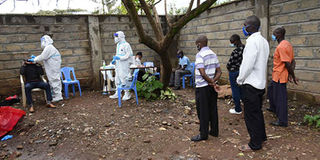No end in sight as Kenya battles coronavirus

Residents of Kawangware, in Nairobi, present themselves for coronavirus testing on May 1, 2020. PHOTO | EVANS HABIL | NATION MEDIA GROUP
What you need to know:
- Kenya is doing at an average of 50 tests per every positive case compared to Uganda and Rwanda, whose numbers are 333 and 100, respectively.
- The country has a problem in providing personal protective equipment, with the ministry saying it has distributed and delivered 3,682.
On Friday March 13, Health Cabinet Secretary Mutahi Kagwe stood on the steps of Harambee House to announce Kenya’s first coronavirus case.
From then on, the country began what has been a 56-day battle with an invisible deadly adversary.
Kenya has witnessed weeks of missed targets, recoveries, tens of deaths and an on-and-off strategy in a fight plagued by delayed mass testing and rising community infections.
After a month of announcing infection numbers from people who had been in mandatory quarantine, the virus sneaked into communities on April 23, when confirmed cases rose to 320.
Fifteen of the 17 people who tested positive had no known history of travel outside the country. The biggest hurdle to the war on the virus is testing.
The World Health Organisation says lack of it will be “like fighting a fire blindfolded”.
Kenya is doing at an average of 50 tests per every positive case compared to Uganda and Rwanda, whose numbers are 333 and 100, respectively.
South Africa had done more than 270,000 tests by Thursday. Testing helps understand the magnitude of the problem and is also crucial when it comes to deciding what measures to take.
TESTING PLAN
The ministry had projected that Kenya would have about 10,000 cases by the end of last month.
This modelling used a number of parameters, one being testing of 200,000 to 300,000 people by April 30.
Authorities have announced targeted mass testing. However, less than 30,000 people have been tested, with the highest number a day being 1,564.
The plan to test 200,000 to 300,000 people by the end of April has been postponed. The government now says it will have tested 250,000 people by the end of next month.
Economist Kwame Owino faults the government’s testing plan. “I pity officials in the ministry. They understand the logic of mass testing but are constrained by the fear from citizens who know that once they test positive, the financial cost of quarantine and the conditions are terrible,” Mr Owino tweeted.
His solution? Encourage people to take the tests. Those who do should be entered into a lottery with a 1:100,000 possibility of winning a prize.
“From this calculation, it would cost government just Sh47 million to conduct tests equal to the size of Kenya’s population. It also means that the prizes would be won by 470 people but its overall cost is a shilling for every person tested,” he said.
INADEQUATE KITS
The Kenya Medical Research Institute (Kemri) has 15 testing centres in Nairobi, Kilifi and Kisumu, as well as at its laboratories.
One can also be tested for Covid-19 at Aga Khan University, Kenyatta National and Nairobi hospitals, Walter Reed in Kericho, Lancet, Coast General Hospital and the National Public Health Laboratories Services.
Kenya’s battle against the virus is not just about testing limitations. The country has a problem in providing personal protective equipment, with the ministry saying it has distributed and delivered 3,682.
Doctors’ unions and associations say the country needs 8.2 million surgical masks, 4.1 million in equal quantity of N95 masks, disposable gowns, caps, hazmat suits, shoe covers and face shields, as well as 92,000 goggles.
In the past week, some 20 county governments have bought 315 complete personal protective equipment and 30,000 assorted gear, the Council of Governors said on Wednesday.
Then there is the problem of intensive care units — the sick part of the country’s healthcare. There are 518 beds in 79 public and private hospitals.
Some 448 are in use. The ministry says the country has a shortage of 190 Covid-19 ICU beds.
Kenya has been lucky because 70 per cent of the coronavirus patients show no symptoms, meaning they do not require much medical care, let alone ICU beds.
TRAINING OF WORKERS
There are 297 functional ventilators in the country. Ninety of these are available in public hospitals.
“There is a shortage of basic oxygenation equipment. These gadgets are critical when managing Covid-19 patients who may develop mild to moderate illness,” the Health ministry said in its report to the Senate.
It added that Kenya requires 3,116 isolation beds, 2,280 of them in counties, to cater for patients who might not require ventilators and the ICU.
The country also faces a shortage of beds, with 48,000 in 839 hospitals above level four. Twenty-eight counties have a below-average bed capacity, the ministry said.
To address this problem, the ministry has set up 458 isolation centres with a bed capacity of 138,000.
In its May 1 update, the ministry said it would build more labs for coronavirus testing in Busia, Machakos, Kitale and Malindi.
It also pledged to scale up training of health workers and restricting travel.
Mr Kagwe became minister on the same day he was made chairman of National Emergency Response Committee, the team leading the fight against the virus.
For President Uhuru Kenyatta, the pandemic has become a delicate balancing act of enforcing containment measures while ensuring Kenyans can still put food on their tables.






